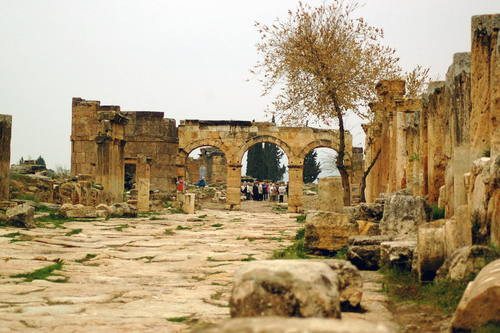Toxic breath of mythological hellhound at ancient city of Hierapolis identified as volcanic fumes
Nicknamed the Gates of Hell, the site emits deadly CO2 fumes from volcanic fissures underneath.

New research on the ancient Greco-Roman city of Hierapolis has uncovered the secret behind one of its age-old mysteries. Nicknamed the "Gates of Hell" or "Pluto's Gate", the site in modern-day Turkey was considered to be the entryway into the underworld.
Built in 190 BC, the temple complex became famous as a place where castrated priests would perform ritual animal sacrifices by taking the offerings of bulls and birds into the lower chambers where they would die without human intervention. The priests themselves would return unharmed but in a hallucinatory state.
The toxic vapours which were released from the stone entrance resembled either the deadly breath of Pluto/Hades, the Greek god of the kingdom of death or even more plausible, the breath of the frightening hellhound Kerberos who stood guarding the entrance to hell.
However, a study published in Archaeological and Anthropological Sciences on 12 February has now revealed that volcanic fissures in the earth below the city's temple, and not any mythological creature, was responsible for the "miracles" that caused the animals to die without adversely affecting the humans.
Using a portable gas analyser system, scientists were able to identify the geogenic gas regime in the area. "In a grotto below the temple of Pluto, CO2 was found to be at deadly concentrations of up to 91%. Astonishingly, these vapours are still emitted in concentrations that nowadays kill insects, birds, and mammals," according to the study.
"The concentrations of CO2 escaping from the mouth of the grotto to the outside atmosphere are still in the range of 4–53% CO2 depending on the height above ground level."
At night, these concentrations increase and would be able to kill a human being within a minute.
The origin of the geogenic CO2 is the still active seismic structure that crosses the old town of ancient Hierapolis as part of the Babadag fracture zone. Over 2,000 years ago, people were unable to scientifically determine the cause of geological gas emissions and attributed it to the divine. Temples and sanctuaries were most often constructed at these sites.

Lead author of the study, Professor Hardy Pfanz of the Institute of Applied Botany and Volcano Biology at the University of Duisburg, notes that during important ceremonies, bulls and rams were also ushered into the ante chambers of the sanctuary where their nostrils would be at the level of the fumes.
The priests, however, would have stood straight and held their noses high. "The spectators could see that animals as strong, sturdy, and powerful as bulls died within minutes whereas the priests survived," Phanz wrote, adding that the priests may have been aware of the properties of the gas and the level at which the fumes were most concentrated.
He assumes that animal sacrifices would have been scheduled for evenings or early mornings when the percentage of CO2 was the highest but displays of the priests' god-like powers would have been performed midday when the air was least toxic.






















